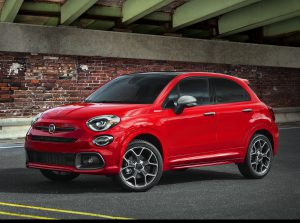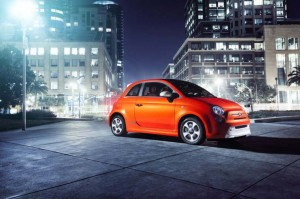
Fiat’s only U.S. offering for the 2021 model-year will be the 500X, a moderately revised version of the Jeep Renegade.
Fans of the Fiat 124 Spider better be racing to showrooms if they want one of the little roadsters as there’ll be no more of them coming to the U.S. market for the 2021 model-year, the automaker has announced.
The subcompact Fiat 500L crossover also is being culled from the line-up for 2021, following the once iconic 500 microcar that vanished after the 2019 model-year. All three products were victims of slow and declining sales.
“For the 2021 model year, the Fiat lineup will feature the Fiat 500X small crossover, which offers unique and functional Italian design, standard all-wheel-drive capability, 9-speed automatic transmission, 30 mpg highway and best-in-class 210 lb-ft of torque,” the Italian brand said in a statement confirming long-standing rumors that, “The Fiat 124 Spider and the Fiat 500L will be discontinued after the 2020 model year.”
For those that follow the industry and, in particular, the Fiat brand, the news was anything but a surprise.

Unveiled for 2017, the Fiat 124 Spider brought back a once legendary name, but the roadster was part of a joint venture and shared underpinnings with the latest-generation Mazda Miata.
A decade ago, when Fiat came to the rescue of floundering Chrysler, securing a federal bailout with the merger creating Fiat Chrysler Automobiles, there were high hopes for the Italian brand. It had pulled out of the American market in 1983, a victim of poor quality and increasingly irrelevant products. But FCA’s CEO Sergio Marchionne laid out a grand plan to bring it back, while also building up the Italian company’s more upscale Alfa Romeo and Maserati marques.
But, for the Fiat brand, things went wrong right from the start. The launch of the original 500 model was seriously botched, far fewer dealers lined up than expected, for one thing. Laura Soaves, the executive running the revival was summarily dispatched less than a year later.
Not everything was her fault, however. Soaves had laid out an ambitious target backed by projections that small car sales in the U.S. would nearly double between 2011 and 2014, to around 1 million annually. While soaring fuel prices initially helped move things in the right direction, demand soon lost momentum as Americans by the million shifted from sedans, coupes and hatchbacks to SUVs and CUVs.
(The FCA/PSA deal is not exactly a “merger of equals.”)
Fiat responded with two new entries, the microvan-like 500L and the more utish 500X. While the X did generate some buzz, the L was largely dead on arrival.

The launch of the Fiat 500 was a disastrous mess and the addition of an all-electric 500e did little to salvage things.
The brand, as a whole, wasn’t doing much better. In 2012, Fiat’s first full calendar-year in the U.S. market, sales totaled 46,999. Rather than marking a starting point, it would prove to be the automaker’s all-time high. By 2018, sales slipped to 15,521 and tumbled below the five-digit market a year later, to a mere 9,204. So far, this year, demand has been averaging below 400 vehicles a month, sales showing little upward momentum as the overall market has begun recovering from the pandemic’s spring slump.
“Their sales are floundering,” writes analyst Timothy Cain in the automotive research site GoodCarBadCar. Demand has now reached “the lowest mark of the company since their reintroduction to the US market after a 25 year absence.”
During a splashy June 2018 event designed to outline the company’s next five-year strategic plan, CEO Marchionne took pains to say Fiat was here to stay, both in the U.S. and worldwide. But not everyone was convinced by the presentation – which was notably short on detailing future product plans. “There was enough doubt…about their future because they barely showed up in the presentations,” said Joe Phillippi, chief analyst with AutoTrends Consulting, after attending the event in Milan.
Little to nothing has been done since then to improve confidence in the Fiat brand, especially following Marchionne’s unexpected death a month later.

Even gussied up concept versions couldn’t do much to build interest in the Fiat 500L which also will vanish for 2021.
His successor, Mike Manley, hasn’t written off Fiat, at least not publicly, but he will have a diminished role come the first quarter of 2021. That’s when Fiat Chrysler and France’s PSA expect to complete the merger that will create Stellantis. The combined company will become the world’s fourth-largest automaker by volume. And it will rival industry top dog Volkswagen Group in terms of its total brand count. The French company not only will bring in familiar Peugeot and Citroen but newer luxury brand DS, as well as the Opel and Vauxhall brands purchased from General Motors a few years back.
PSA’s current CEO Carlos Tavares will retain his role under Stellantis. Ironically, he’s also looking to bring back to the U.S. the French automaker’s flagship Peugeot, which has been out of the market for nearly three decades. Whether Tavares will have patience to rebuild Fiat, as well, is uncertain – though, as the new Stellantis head of the Americas, Manley could argue in its favor – if so inclined.
But there are plenty of observers – and more than a few within FCA – who think the merger will bring to an end the Fiat experiment. Indeed, its future is far from certain worldwide, though it does fare better in some global markets.
(Review: A week with the Fiat 500X.)
For now, the 2021 model-year will see Fiat’s U.S. showrooms selling just the one model, the Fiat 500X a slightly redesigned version of the more popular Jeep Renegade. That said, shoppers looking for bargains may also find steeply discounted leftovers of the 124 roadster and 500L crossover for some time to come.